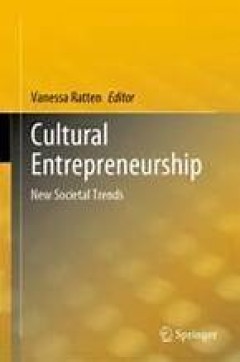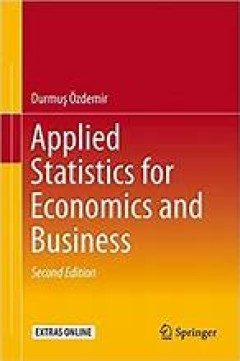Filter by

Cultural Entrepreneurship
Cultural entrepreneurship uses culture as a way to understand innovative business ventures. Culture in this edited book involves the beliefs and values associated with certain forms of behaviour. This means the way individuals are involved in business ventures is based on their cultural ideas. This edited book focuses on how cultural entrepreneurship is an important way to understand how cultur…
- Edition
- 1
- ISBN/ISSN
- 978-981-19-2771-3
- Collation
- Business
- Series Title
- -
- Call Number
- 650

Corporate Entrepreneurship
Das Lehrbuch bietet einen umfassenden Einblick in die unternehmerische Gestaltung des Management in etablierten Unternehmen. Gekennzeichnet durch die Dimensionen Innovativität, Proaktivität und Risikobereitschaft ist Corporate Entrepreneurship heute belegbar ein wichtiger Faktor für nachhaltigen Unternehmenserfolg. Die Autoren beleuchten das Konzept wissenschaftlich und präsentieren die Erk…
- Edition
- 1
- ISBN/ISSN
- 978-3-658-00646-4
- Collation
- Business and management
- Series Title
- -
- Call Number
- 650.1

Kommunikation in Open Innovation-Prozessen von kleinen Unternehmen
Inga Haase zeigt nicht nur, dass Kommunikation ein wichtiger Einflussfaktor im Kontext von Open Innovation ist, sondern auch, über welche Faktoren, Strukturen und Ebenen sie die Open Innovation-Prozesse und -Aktivitäten kleiner Unternehmen beeinflusst. Die Autorin analysiert in diesem Zusammenhang die einzelnen Bereiche Kommunikation, Innovation, Innovationskommunikation, Controlling und Wert…
- Edition
- 1
- ISBN/ISSN
- 978-3-658-23822-3
- Collation
- Business and Economics
- Series Title
- -
- Call Number
- 650.1

The Founder’s Investor Choice
A founder’s decision for an investor can substantially influence the new venture’s success. Two common types of venture capital (VC) are independent venture capital (IVC) and corporate venture capital (CVC). Previous research focused on the investor’s perspective and studied the distinct differences between IVC and CVC, their value-adding capabilities, and risks. In contrast, as founders�…
- Edition
- 1
- ISBN/ISSN
- 978-3-658-35345-2
- Collation
- Business Management
- Series Title
- -
- Call Number
- 650.1

Enterprise Risk Management in International Construction Operations
This book provides readers an understanding of the implementation of Enterprise Risk Management (ERM) for international construction operations. In an extended case study, it primarily focuses on Chinese construction firms (CCFs) based in Singapore. In this regard, the book explains the differences and similarities between Risk Management (RM), Project Risk Management (PRM) and ERM in the const…
- Edition
- 1
- ISBN/ISSN
- 978-981-287-549-5
- Collation
- Business Management
- Series Title
- -
- Call Number
- 650

The Palgrave Handbook of Servitization
Manufacturers have shifted their focus from products to smart solutions in search of higher returns and additional growth opportunities. This shift, described as servitization, or lately as a digital servitization, is not a simple process. Academic study has revealed that its issues are complex, problematic, contingent, and even paradoxical, involving multiple organizational layers, such as op…
- Edition
- 1
- ISBN/ISSN
- 978-3-030-75771-7
- Collation
- Business Management
- Series Title
- -
- Call Number
- 650

Applied Spectroscopy and the Science of Nanomaterials
This book focuses on several areas of intense topical interest related to applied spectroscopy and the science of nanomaterials. The eleven chapters in the book cover the following areas of interest relating to applied spectroscopy and nanoscience: · Raman spectroscopic characterization, modeling and simulation studies of carbon nanotubes, · Characterization of plasma di…
- Edition
- 1
- ISBN/ISSN
- 978-981-287-242-5
- Collation
- Business Management
- Series Title
- -
- Call Number
- 650

Applied Statistics for Economics and Business
This textbook introduces readers to practical statistical issues by presenting them within the context of real-life economics and business situations. It presents the subject in a non-threatening manner, with an emphasis on concise, easily understandable explanations. It has been designed to be accessible and student-friendly and, as an added learning feature, provides all the relevant data req…
- Edition
- 1
- ISBN/ISSN
- 978-3-319-26497-4
- Collation
- Mathematics
- Series Title
- -
- Call Number
- 510

Entrepreneurial Marketing for SMEs
Entrepreneurial Marketing for SMEs contextualizes the practice of marketing amongst SMEs, and critically discusses major issues of Entrepreneurial Marketing with a relevant and up-to-date academic body of knowledge.
- Edition
- 1
- ISBN/ISSN
- 978-1-137-53258-9
- Collation
- Marketing
- Series Title
- -
- Call Number
- 658.8

Entrepreneurial Universities
- Edition
- 1
- ISBN/ISSN
- 978-3-319-47949-1
- Collation
- Manajemen
- Series Title
- -
- Call Number
- 650
- Edition
- 1
- ISBN/ISSN
- 978-3-319-47949-1
- Collation
- Manajemen
- Series Title
- -
- Call Number
- 650
 Computer Science, Information & General Works
Computer Science, Information & General Works  Philosophy & Psychology
Philosophy & Psychology  Religion
Religion  Social Sciences
Social Sciences  Language
Language  Pure Science
Pure Science  Applied Sciences
Applied Sciences  Art & Recreation
Art & Recreation  Literature
Literature  History & Geography
History & Geography